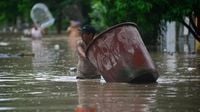Heavy rain and devastating floods swept across Mexico from October 9 to 11, 2025, leaving a trail of destruction and loss in their wake. The unrelenting downpours, which battered 31 of the country’s 32 states, triggered landslides, caused rivers to burst their banks, and resulted in widespread power outages. As authorities rushed to respond, the death toll climbed steadily, with figures ranging from more than 20 to at least 27 fatalities reported by various media outlets and government sources by Saturday, October 11.
The hardest-hit regions included the eastern state of Veracruz, the central states of Hidalgo and Querétaro, San Luis Potosí in the north-central part of the country, and Puebla. According to Mexico News Daily, President Claudia Sheinbaum opened her Friday morning press conference by focusing on the flooding and the tragic consequences it brought. Sheinbaum underscored the scale of the event, noting, “It rained on Thursday in 31 of Mexico’s 32 federal entities. Only in Baja California Sur did it not rain.”
Hidalgo emerged as the epicenter of the disaster. State authorities there reported at least 16 deaths, with more than 1,000 homes and hundreds of schools, hospitals, and clinics suffering damage. Guillermo Olivares Reyna, Hidalgo’s Interior Secretary, said that 17 out of the state’s 84 municipalities were left without electricity after the storms. Landslides and overflowing rivers compounded the devastation, with the Moctezuma and Axtla rivers in San Luis Potosí also bursting their banks, according to Civil Protection chief Laura Velázquez.
In Puebla, Governor Alejandro Armenta said at least three people had died in landslides as of Friday, with another five reported missing. By Saturday, the death toll in Puebla had risen to nine, and the number of missing remained at five. Armenta described a desperate situation, estimating that 80,000 people were affected in his state and requesting federal aid to rescue 15 individuals—including children—stranded on rooftops by rapidly rising floodwaters. A gas pipeline in Puebla was also ruptured by a landslide, raising further safety concerns.
Veracruz, on the Gulf Coast, was another area pummeled by the relentless rains. Authorities there reported at least two deaths, including a police officer, and widespread destruction in cities like Poza Rica and Álamo. The city of Poza Rica was particularly hard-hit by river flooding, prompting officials to cut electricity as a precautionary measure. In Álamo, 5,000 homes were damaged, and emergency shelters were quickly set up for displaced families.
Querétaro and San Luis Potosí also faced significant challenges. The Jalpan River in Querétaro overflowed its banks, and landslides were reported in both states. In Querétaro, a child died after being caught in a landslide, highlighting the vulnerability of communities living near unstable slopes. The Federal Electricity Commission worked around the clock to restore power in affected areas, including parts of Veracruz, San Luis Potosí, and Puebla.
According to Reuters and AsiaOne, the Ministry of Defense mobilized more than 5,400 troops to support evacuations, monitor the situation, and assist in the cleanup. President Sheinbaum coordinated efforts to clear roads, restore power, and deliver humanitarian aid. She shared images on social media of rescuers wading through knee-deep water to bring supplies to stranded residents, stating, “We are working to support the population, open roads and restore electrical services.”
Meteorologists attributed the deluge to Tropical Storm Raymond and Hurricane Priscilla, which dumped extraordinary amounts of rain on the Pacific coast and interior regions. Zihuatanejo, Guerrero, saw the highest recorded rainfall—151 millimeters in a single day—amounting to two months’ worth of precipitation, reported Mayor Lizette Tapia Castro. The storms’ lingering presence over the Baja California peninsula and western Mexico prompted warnings of continued risk for further flooding and landslides in the days ahead.
As of Friday, October 10, La Jornada reported 24 rain-related fatalities, while other outlets cited slightly lower numbers. By Saturday, the numbers had climbed: South China Morning Post reported at least 27 deaths, and France24 and other agencies confirmed at least 23. With several people still missing—five in Puebla alone, according to Governor Armenta—the final toll could rise further.
Beyond the immediate tragedy, experts and officials echoed concerns about the broader context driving such extreme weather. Climate change, they warned, is intensifying Mexico’s wet season, increasing the frequency and severity of floods and landslides. As Reuters noted, these events “underscore the need for effective coordination among government authorities, emergency services, and the public to reduce losses and save lives.”
Emergency shelters, coordinated by Civil Protection and local governments, provided refuge for those displaced by the floodwaters. The army and navy joined the response, delivering food, water, and medical supplies to affected communities. In Álamo and other towns, families huddled in makeshift shelters, uncertain when—or if—they could return to their homes.
Amid the disaster, officials urged citizens to remain vigilant and heed official advisories. Civil Protection chief Velázquez advised, “Rain would continue to fall in different parts of Mexico on Friday,” and recommended that people stay alert to official communication channels and follow “all the recommendations” issued by Civil Protection authorities.
The scale of the damage was staggering: in Hidalgo alone, 59 hospitals and clinics and 308 schools were affected, disrupting essential services and education for thousands. In Puebla, the rupture of a gas pipeline added a hazardous dimension to the crisis, and in Veracruz, the precautionary power cuts left entire neighborhoods in darkness as they waited for the waters to recede.
By the weekend, rescue operations continued in earnest. Troops and emergency responders navigated flooded streets, set up reception points for evacuees, and worked to repair critical infrastructure. The government’s message was clear: the situation remained challenging, and the threat from further rainfall was far from over.
As Mexico grapples with the aftermath, the nation’s resilience and the tireless efforts of its emergency services stand out. But the events of this week also serve as a sobering reminder of the growing risks posed by climate change and the urgent need for preparedness in the face of increasingly unpredictable weather.
With communities still counting the cost and searching for missing loved ones, the story of these floods is far from finished. For now, the focus remains on recovery, relief, and the hope that the rains will finally subside.


